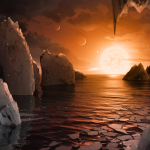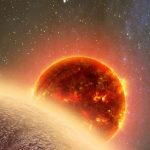Atmosphere containing water detected around rocky exoplanet0
- From Around the Web, Space
- April 13, 2017
An Earth-sized planet orbiting a dim star 39 light years away has a hazy atmosphere that could indicate the presence of a “water world”.

An Earth-sized planet orbiting a dim star 39 light years away has a hazy atmosphere that could indicate the presence of a “water world”.

The prospect of discovering alien life on any one — or several — of the Trappist-1 planets has captivated the imaginations of the people of Earth since NASA broke the news of the red dwarf star’s treasure trove of Earth-sized worlds, not to mention the fact that three — and later four — of the seven planets were located within the star’s habitable zone. And now, a study has emerged presenting the probability with which alien life might have prospered within the Trappist-1 planetary system through panspermia (that is, moving from world to world via collision and or ejecta transference).

NASA’s Spitzer Space Telescope has revealed the first known system of seven Earth-size planets around a single star.

For the first time ever, ESO astronomers have been able to capture a clear image of a star system 11 quadrillion kilometers away using the combined forces of the Very Large Telescope (VLT) in Chile, the Keck Observatory in Hawaii, and the Calar Alto Observatory in Spain.

According to astronomers, the distant planet GJ 1132b has plenty of oxygen, but no life on the surface.

Alien worlds orbiting within the habitable zones of small red dwarf stars may become truly habitable if their atmospheric circulation balances the temperature extremes.

Using NASA’s Hubble Space Telescope, astronomers have conducted the first search for atmospheres around temperate, Earth-sized planets beyond our solar system and found indications that increase the chances of habitability on two exoplanets.

104 new exoplantes discovered by an international science team led at the University of Arizona.

Water is a hot topic in the study of exoplanets, including “hot Jupiters,” whose masses are similar to that of Jupiter, but which are much closer to their parent star than Jupiter is to the sun. They can reach a scorching 2,000 degrees Fahrenheit (1,100 degrees Celsius), meaning any water they host would take the



